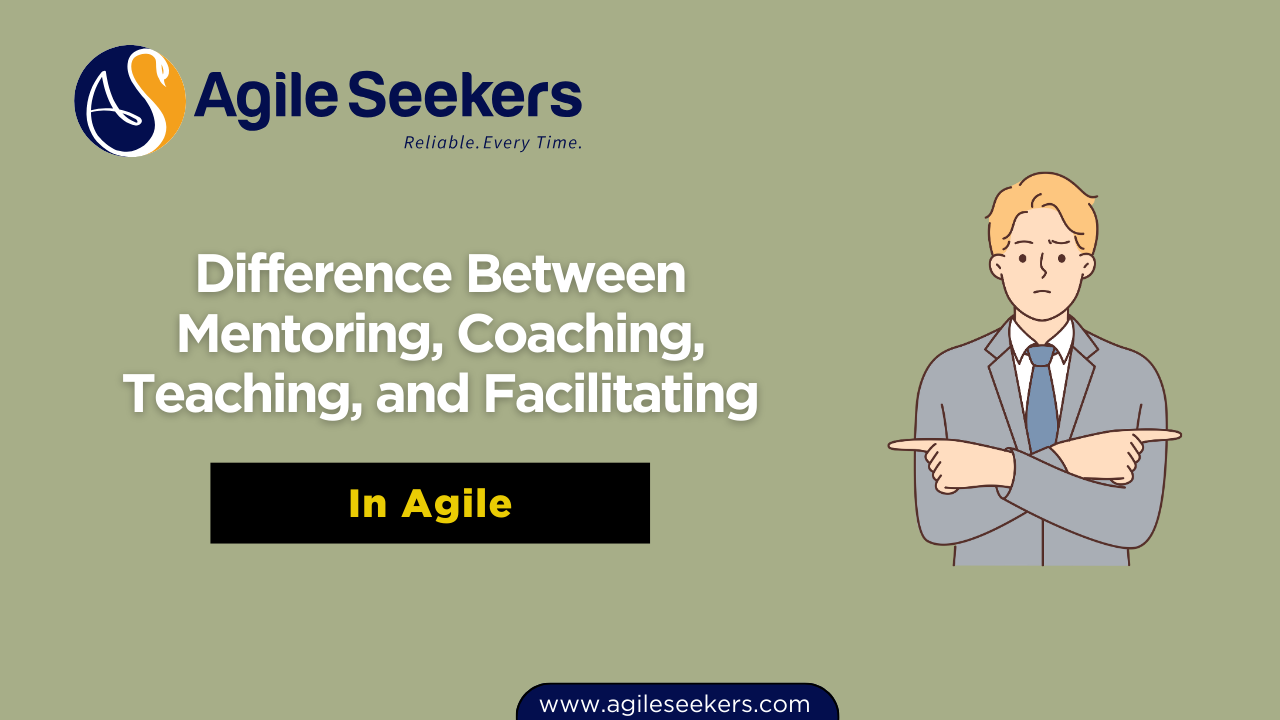The Difference Between Mentoring, Coaching, Teaching, and Facilitating in Agile

In an Agile environment, individuals and teams are constantly evolving. To support this evolution, organizations rely on skilled professionals who can guide, empower, and enable growth through various support roles—most commonly mentoring, coaching, teaching, and facilitating. While these terms are often used interchangeably, each plays a distinct role in shaping Agile maturity and performance.
Understanding the differences between these approaches is essential for Agile practitioners, Scrum Masters, Product Owners, and Agile Coaches who want to provide the right type of support at the right time. Let’s explore each in detail.
1. Mentoring in Agile
Definition:
Mentoring is a relationship-based approach where a more experienced professional (the mentor) shares their knowledge, wisdom, and insights with a less experienced individual (the mentee).
Purpose in Agile:
Mentoring is particularly helpful when team members are new to Agile frameworks or are taking on new roles like Scrum Master or Product Owner. A mentor can offer real-world guidance, help avoid common pitfalls, and share proven practices from their own experience.
How Mentoring Works:
- Focuses on long-term career growth.
- Often informal and ongoing.
- Involves sharing personal experiences and lessons learned.
Agile Example: An experienced Release Train Engineer mentoring a newly appointed Scrum Master by sharing practical approaches to resolving team conflicts or managing dependencies within the Agile Release Train.
When to Apply:
- When an individual seeks career direction or role clarity.
- When transitioning into leadership roles in Agile.
Related Training: Those looking to grow into mentorship roles or benefit from one often pursue foundational certifications like the Leading SAFe Agilist Certification.
2. Coaching in Agile
Definition:
Coaching in Agile is a facilitative process aimed at unlocking a person’s potential to maximize their performance. It is future-focused and helps individuals and teams find their own solutions through deep listening and powerful questions.
Purpose in Agile:
Agile coaching helps teams become self-organizing and improve their processes through guided reflection and experimentation.
How Coaching Works:
- The coach doesn’t give direct answers.
- Focuses on mindset shifts, team dynamics, and systemic change.
- Encourages ownership and autonomy.
Agile Example: An Agile Coach working with a Scrum team that struggles with velocity fluctuations might guide them through retrospectives, help them uncover root causes, and support them as they co-create improvement actions.
When to Apply:
- When a team needs to improve its Agile maturity.
- When dealing with resistance to Agile change.
- When fostering continuous improvement.
Recommended Certification: Aspiring coaches should consider the ICP-ACC Certification, which equips learners with core competencies in Agile coaching, emotional intelligence, and team facilitation.
3. Teaching in Agile
Definition:
Teaching is a directive, knowledge-transfer approach where the teacher delivers information, skills, or theory to a learner.
Purpose in Agile:
Teaching is essential for onboarding new teams to Agile, explaining frameworks like SAFe or Scrum, and ensuring a shared understanding of Agile principles.
How Teaching Works:
- Instructor-led and structured.
- Focused on knowledge acquisition.
- Often uses presentations, exercises, and discussions.
Agile Example: An Agile trainer conducting a workshop to help Product Owners understand user story mapping, backlog refinement, and value delivery.
When to Apply:
- When introducing Agile frameworks to new teams.
- During role-based training for Scrum Masters or Product Owners.
- When upskilling the workforce on specific practices.
Common Scenario: Teaching often precedes coaching or mentoring. For example, before coaching a team to self-manage their work, they must first be taught how to use Agile tools and practices effectively.
Related Training Path: Consider certifications like Leading SAFe to build strong teaching capability in Agile principles.
4. Facilitating in Agile
Definition:
Facilitation is a neutral, process-oriented role where the facilitator guides a group through a collaborative process to achieve a shared goal, without influencing content or decisions.
Purpose in Agile:
Facilitators help teams navigate structured events such as daily stand-ups, planning sessions, retrospectives, or team workshops, ensuring every voice is heard and the objective is met.
How Facilitation Works:
- Creates a safe space for discussion.
- Uses techniques to manage group dynamics.
- Encourages participation, alignment, and decision-making.
Agile Example: A Scrum Master facilitating a retrospective using Liberating Structures to draw out insights from team members and drive continuous improvement.
When to Apply:
- During Agile ceremonies (Sprint Planning, PI Planning, etc.).
- While conducting workshops or value stream mapping.
- When dealing with cross-functional collaboration.
Comparing the Four Roles
| Aspect | Mentoring | Coaching | Teaching | Facilitating |
|---|---|---|---|---|
| Focus | Career growth | Performance and mindset | Knowledge transfer | Collaboration and process |
| Approach | Directive and experience-based | Non-directive, question-driven | Directive and content-driven | Neutral and process-driven |
| Duration | Long-term | Medium to long-term | Short-term | Session-based |
| Goal | Support role transition | Unlock potential | Build understanding | Enable team outcomes |
When to Use What in Agile?
Understanding when to apply each role is critical to supporting Agile maturity:
- New Team Formation: Start with teaching Agile basics, then shift to coaching and facilitation.
- Scaling Agile: Use mentoring to guide leaders, while certified coaches support mindset transformation.
- Continuous Improvement: Coaching and facilitation help teams reflect and evolve.
- Role Onboarding: Combine teaching and mentoring for knowledge and practical growth.
Final Thoughts
Agile transformation is not a one-size-fits-all journey. It requires the right mix of knowledge transfer, mindset coaching, and practical guidance. Whether you're teaching the foundations, coaching through resistance, mentoring new leaders, or facilitating collaboration—each role serves a unique purpose.
To elevate your skills in Agile enablement, explore certifications like Leading SAFe or the ICP-ACC Agile Coach Certification. These programs will help you guide individuals and teams more effectively in their Agile journeys.




















